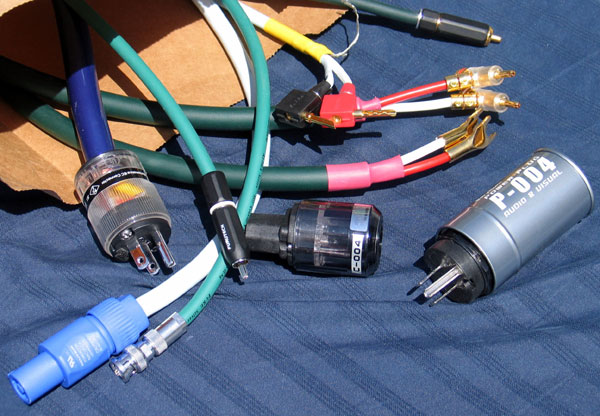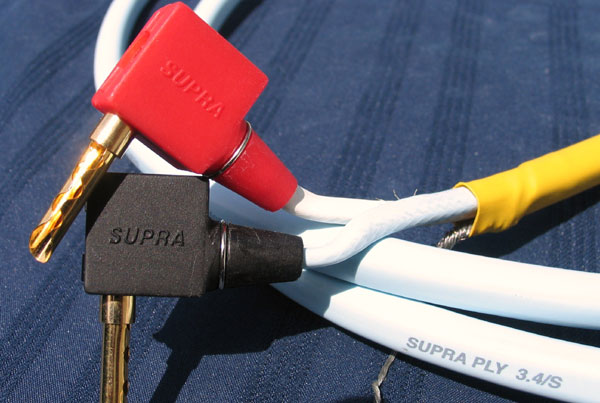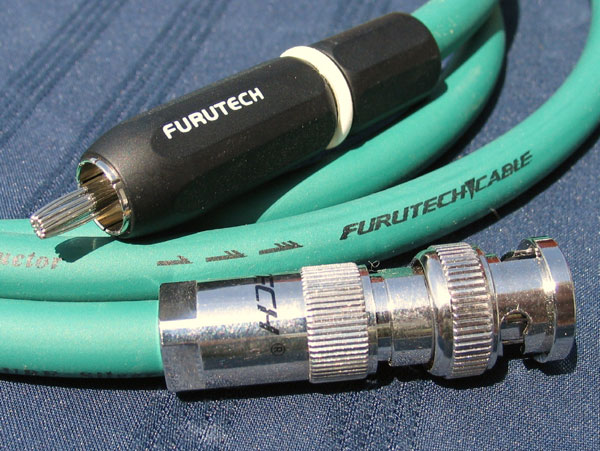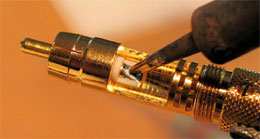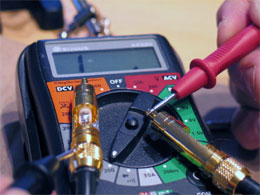![[SoundStage!]](../sslogo3.gif) D-I-Why & How D-I-Why & HowBack-Issue Article |
||||||||||
June 2008 Upgrading Your Cables Without Breaking the Bank Audio cables are controversial and evoke considerable and often heated debate. If there’s an online cable discussion that hasn’t degenerated into a name-calling, flame-throwing insult fest, I haven’t seen it -- and not for a lack of looking. But if there’s one thing that almost all audiophiles do agree on it’s that some audio cables are monstrously overpriced. Although it might sometimes seem that the world of high-performance cables is devoid of bargains, that’s not the case. In fact, if you’re willing to forgo fancy packaging and trim and put in a bit of effort, it’s not at all difficult to assemble a high-performance cable package that will be easy on your ears and your bank account.
Many audiophiles aren’t aware that some of the biggest names in cable offer their products in bulk form. As the name implies, bulk cable is offered off the roll, in whatever length is needed. Terminating the cable is left up to you. But that doesn’t mean you necessarily need to invest in a soldering iron. With the right connectors, it’s possible to assemble an entire set of cables with only a couple of screwdrivers. Some ability to solder, though, makes it possible for the DIYer to choose from a much wider variety of connectors. Bulk cable is usually sold per foot or meter of wire; for an 8' pair of speaker cables, for example, you’d need to buy 16 feet of cable. Generally speaking, connectors are the most expensive part of a completed cable. A set of four good-quality RCA connectors, for example, will probably fall in the $60 to $100 range. Power-cord connectors can be significantly more expensive than the cable to which they’re attached. By combining high performance and great value, bulk cable is a no-brainer for inclusion in the regular "D-I-Why & How" repertoire, and I’ll be revisiting the topic from time to time. First up in this ongoing survey are cables and connectors from DH Labs, Furutech and Supra Cable. Supra Cable In Europe, Supra Cable is well known as an award-winning maker of high-performance cables. In North America, the company is relatively unknown. That needs to change, because Supra Cable not only makes great products, but they’re a very DIY-friendly company. Of Supra’s wide range of audio, power, digital and video cables, all but the flagship Sword series are available in bulk. Supra, founded in Sweden in 1976, is by all indications utterly disinterested in hyperbole. The company’s cable catalog, which is supposed to be marketing material, reads like an engineering report. Dry headlines like "Supra Ply, a Logical and Scientific Design" are typical. It’s an interesting read, though, and educational too. For example, according to Supra the typical speaker cable emits more electromagnetic interference (EMI) than the typical power cord. Most of Supra’s cable is composed of very pure tin-plated copper. I can see raised eyebrows from here. Tin? Well, Supra offers some pretty solid reasoning for using tin rather than the more common silver plating. The company says that its tin plating offers higher resistance to electron flow than the underlying copper and therefore the tin acts as a barrier between individual wire strands in a Litz-like manner. This reduces skin effect, or an electron’s tendency to want to flow along the outer edge of a strand or wire where resistance is higher.
Supra’s bulk-speaker-cable lineup consists of the Classic, Rondo, Linc and Ply families, and I was provided samples of the latter three by Sjofn Hifi, Supra’s American importer. In keeping with its European origins, Sjofn sells Supra cable by the meter. List prices are $15 per meter for the Rondo 4 x 2.5, $9 per meter for the Linc 2 x 2.5, and $18 per meter for the Ply 3.4/S. All Supra speaker cables were terminated in the "DI Why & How" labs (my kitchen) using Supra’s unique banana plugs ($25 per pair), which do not require soldering. While all of Supra’s other speaker cables are of conventional round cross-section, the Ply3.4/S is quite different. This cable is composed of multiple strands of wire woven into a rectangular section. Supra says that its rectangular geometry offers the performance advantages of a ribbon cable (low inductance and resistance) without the manufacturing and termination difficulties inherent in ribbon designs. As for the shielding, Supra claims that its role is twofold: to keep EMI out of the audio signal and to keep the cable’s own radiation in. This, they say, prevents the high-energy signal in the speaker cables from interfering with low-level cables such as interconnects. To drain away interference, Supra recommends grounding the shield to a phono ground or bare-metal screw on your preamp or amp’s chassis. I used alligator-clip-equipped wire to ground the shield to my Simaudio Moon i5.3’s chassis.
Supra’s house signature is neutrality. The Supra cables sampled here are adept at getting out of the way and not attracting attention to themselves. All three cable sets were smooth and detailed, with the shielded Linc offering greater detail and air than the unshielded Rondo, but not as much punch. This is probably due to the latter’s quad core of heavy conductors. The top-of-the-line Ply3.4/S offered a combination of the traits of the other cables and was easily the top performer of the three Supra cables. The Ply 3.4/S is a very articulate cable, which, probably thanks to its shield and low noise level, enhanced my reference system’s ability to convey minor background details without causing me to strain to hear them. Treble reproduction is light and airy for the most part, though with metal-dome tweeters, such as that found on the B&W CM1, it can be a little glaring at times. Bass is tight and tuneful through the Ply 3.4/S -- in fact, bass reproduction is one of this cable’s real strengths. Overall, the Ply3.4/S is a neutral, musical and quiet cable that really exceeds expectations. In fact, all three Supra speaker cables would be bargains above their asking prices. Like its speaker-cable cousins, the Lo-Rad 3 x 2.5 power cord ($16 per meter) also does a fine job of disappearing. The Lo-Rad uses a unique and patented semi-conductive insulator over the ground wire to drain EMI to ground, and it’s claimed to be the only audio-grade power cord in the world to meet the European Union's über-strict standards for EMI radiation. This makes it a fine choice where it’s difficult to keep signal cables and power cords physically separated from one another. Given the cable’s specs, I thought it would make a fine power cord for the digital board of my Audio Note Kits DAC 2.1 (I use separate cords for the digital and analog sections) and indeed it offered a completely clean electrical feed. That is to say that the Lo-Rad did not color the sound in any way. What it did do was remove some proverbial veils, letting more detail come shining through. It wasn’t a startling change by any means, but one that was easily noticeable. For the paltry sum of $16 for a three-foot length of Lo-Rad, it’s easy to recommend. Welcome to the Americas, Supra. What took you so long? Furutech Furutech offers bulk interconnect cable starting at less than $2 per foot, but this Japanese company is probably best known for its cables at the high end of the bulk-cable price and performance spectrums. Furutech’s Canadian importer, Audiyo.com, provided a wide variety of cables and connectors for evaluation. All of Furutech’s cables and connectors undergo the company’s proprietary demagnetization and cryogenic treatments, which are said to enhance performance. Where appropriate, each cable was soldered using Mundorf’s excellent silver/gold solder. The thick and unwieldy FP-3TS862 10-gauge power cord ($27.84 per foot) is the most difficult-to-terminate cable that I’ve encountered -- ever! It literally took me three days of trying, retrying, cursing, sweating and blistering my fingers before I could force the cable’s massive conductors into the FI-25M (R) ($105) and FI-25 (R) ($78.70) connectors, which inexplicably are made only for cables up to 12 gauge (the smaller the gauge number the bigger the cable). The trick to terminating this behemoth of a cable, it turns out, is to separate each conductor into two ends, like a snake’s forked tongue. You see, the mechanism in the connectors that grasps the cable is tightened with a screw, and that screw runs right through the middle of the mechanism. So splitting the conductors into forks permits it to go around the screw from both sides. Simple, but not too bloody obvious. Yes, the FP-3TS862 was a real pain to work with, but does it ever make a great power cord. It’s not too often one can speak of a cable that instantly transforms a system, but the FP-3TS862 is one. When powering my Simaudio Moon i5.3 integrated amp, everything improved with the FP-3TS862: better detail, stronger bass, cleaner highs, a blacker background and a more three-dimensional soundstage. This cable absolutely smoked the Shunyata Snake Bite power cord it replaced. It might cost three times more than the Shunyata, but the Furutech is easily ten times better. For all the trouble the FP-3TS862 caused, it was worth it in the end. This is a seriously high-performance cable. It’s not cheap, but it’s worth every penny. The FP-314Ag ($11.67 per foot), Furutech’s 15-gauge power cable, easily terminated with the FI-11M (Cu) ($35.60) and the FI-11 (Cu) ($35.60), was assigned the duty of powering the tube-regulated power supply in my DAC 2.1. This little guy offered benefits similar to those of its bigger brother and its most noticeable achievement was lowering the tube section’s noise floor. Interestingly, where before a whisper of tube rush was always apparent (ear on speaker), with the FP-314Ag it was gone. I noticed, too, that the FP-314Ag got more out of the DAC’s Amperex 6922 output tubes. The legendary smoothness and sublime midrange of the 6922s was still there, but the bass tightened up and gained some heft and punch. The FX-á-Ag ($16.65 per foot) digital and FA-13S ($11.07 per foot) interconnect cables are as different from one another as cables can be. The former is a pure-silver stranded-core coaxial cable, while the latter uses two massive (for an interconnect) 16-gauge solid-core conductors in a twisted-pair configuration. The FX-á-Ag is supremely flexible, while the FA-13S is as stiff as one would expect: Bend the FA-13S into a shape and it will stay that way for eternity. To counteract the solid-core cable’s tendency to want to ring like a bell, Furutech twists the conductors with soft cotton filaments in between. These seem to do a very effective job of damping the cable. To suit the peculiar needs of the DAC 2.1 at one end and the Blue Circle USB Thingee at the other, the FX-á-Ag was terminated with the FP-3-117 (R) BNC connector ($40.40 per set) at the DAC end and the FP-120F (R) male RCA ($33.20 each) where it met the Thingee. The FA-13S was terminated with the FP-110 (G) ($25 each) male RCA at all four ends.
Both cables are quite nimble compared to the DH Labs D-75 digital and Tara Labs RSC Prime interconnects that they replaced, and they offered faster transient response and greater detail. The FP-13S is a somewhat dryer-sounding cable than the RSC Prime, but it has the edge in bass impact, attack and decay. FX-á-Ag is a terrific digital cable, though it sounds a smidgen softer than the D-75, perhaps an effect of its stranded core of fine silver wires, versus the D-75's solid-silver-over-copper core. This softness translated into bass that was slightly less focussed than with the D-75, though in every other measure the five-times-more-expensive FX-á-Ag topped the D-75 by a considerable margin. The ì-2T ($8.27 per foot) speaker cable is another that is a little too big for its Furutech connector’s britches. In this case, the cable’s inner insulators are the tiniest bit too big to easily fit into Furutech’s jewel-like FP-201 (G) spades ($13 each) and FP-202 (G) locking banana plugs ($17 each). Once forced in, though, finishing the job of terminating the speaker cable is as easy as tightening two screws. To put less strain on the wire stands, it’s recommend that the top screw be used to crimp the wire to the connector and the bottom screw be tightened against the cable’s insulator. This should make for a tight fit that will prevent the cable from coming loose, even under strain. Of all the Furutech cables, the ì-2T took the longest to break in; only after a couple of hundred hours of constant playing did it seem that the ì-2T had finally settled down. Initially it presented overblown, tubby bass and recessed highs. Detail retrieval, though, was very good to excellent throughout the break-in process. Once fully ready, the ì-2T proved to be an excellent speaker cable. It managed to offer outstanding detail retrieval without sounding bright, etched or tizzy and, unlike the Supra Ply, never offered a strained rendition of brighter recordings through the CM1 speaker. Bass reproduction is well controlled and fast: There’ll be no one-note bass with the ì-2T in the chain. At around $250 for an 8' pair, including Furutech’s lovely spades and banana plugs, the ì-2T is a fantastic bargain. DH Labs This Florida-based company has a solid reputation for making high-value cables and connectors. DH Labs’ BL-1 Series II interconnect is considered by many to be the budget interconnect and for many listeners it's their first high-performance audio cable. The same goes for the company’s well-regarded T-14 and Q-10 speaker cables, which have won over audiophiles and reviewers the world over. For this evaluation, though, I went a little off the beaten path with a listen to DH Lab’s Pro Studio interconnect ($8.95 per foot) fitted with the Ultimate RCA connector ($20 each) and the ST-100 speaker cable ($3.50 per foot) terminated with the DH Labs thin locking banana ($10 each). I also had a look at the VX-1 video cable ($5 per foot) fitted with the RCA-3 connector ($9.95 each).
What makes the Ultimate RCA ultimate? According to DH Labs, its connector is comprised of over 99% copper. That's not just copper purity, but copper content. Most RCA plugs are made from brass (or phosphor bronze in the case of Furutech) and, according to a study commissioned by DH Labs, contain no more than 60% copper content. DH Labs says that its Ultimate RCA is several times more conductive than brass connectors. This, of course, means that the audio signal meets much less resistance through an Ultimate RCA than a brass connector. It doesn’t take a metallurgist to confirm the Ultimate’s high copper content. When soldering the Pro Studio cable to the Ultimate RCA, the connector heated up very quickly. Contrast this with brass connectors, which can take forever to become hot enough to take solder, especially the main body of the connector, to which an interconnect’s return (or negative) lead is attached. As befits anything with such an illustrious name, the Ultimate RCA is beautifully made and finished. Its locking barrel grips as tenaciously as a pit bull. The Pro Studio is DH Labs’ top-of-the-line bulk interconnect cable and was designed with both the DIY community and recording studios in mind. It features twin 22-gauge silver-over-copper conductors and a braided shield offering 95% coverage. The conductors are insulated with a low-density Teflon, which proved very easy to strip away when terminating the cable. A cable designed for studio use should be neutral, clean and transparent, and indeed these adjectives apply to the Pro Studio. This is a very smooth and effortless cable. But that doesn’t mean it’s sluggish or warm. Rather, the Pro Studio is detailed without sounding bright and conveys dynamics as well as the Furutech FA-13S and Tara Labs RSC (both with solid cores). The Pro Studio is just a little more relaxed than the other two cables, though, and isn’t quite on par with the Furutech’s ability to layer a soundstage. As a finished product, the Pro Studio would likely be a $300 cable, but in bulk, a 3' pair terminated with the Ultimate RCA comes in at under $135. That makes the Pro Studio/ Ultimate RCA combo a stellar value. The ST-100 speaker cable features both silver-plated-copper and all-copper conductors that are spiraled together so that an alternating pattern of silver and copper is visible through the cable’s clear insulation. This 14-gauge cable was designed with home-theater applications in mind, so I used it mostly as a surround-channel speaker cable with my Marantz 8400 receiver, replacing some heavily stranded copper cable purchased from speaker maker Axiom Audio. Admittedly, expectations were low for a speaker cable in the surround channels, but the ST-100 surprised by making the surround experience more enveloping than ever before. I’m not a huge home-theater buff because I’ve never found the experience to be all that impressive. I have to admit, though, that the problem might well have been the short shrift I gave the surround channels, with their lower-quality wiring and "whatever is kicking around" speakers. The ST-100 makes me think that I need to get serious with some dipole surround speakers, because there’s more to the surround channels than I’ve previously believed. Of course, I spend 95% of my listening time with stereo music, so the ST-100 spent some time up front, too. There it was clearly not equal to either the Supra Ply or the Furutech ì-2T, but it was by no means a punishing listen. The ST-100 probably isn’t the right choice for critical listening in a system of exceedingly high performance, but it would do very well in a secondary system or in a home theater, which, of course, is where it was destined to be. The ST-100 would certainly be a major step forward over generic cable that is often bought at the time a receiver or speakers are purchased. Although video is a little beyond the intended purview of this column, DH Labs included the VX-1 cable and RCA3 connectors in the box it sent, so it seemed only fair to give them a try. Three lengths of VX-1 were used to replace a Cables-To-Go component cable set, which connects a Samsung DVD player directly to my TV. Compared to what it replaced, the VX-1 was significantly better. Colors were brighter, detail improved and video noise seemed to be completely banished. If you’re not ready to stream your video and audio signals together, a la HDMI, but want better video, the VX-1 should be on your short list. At only $5 a foot, it’s well worth a try. Finally, I would be remiss if I didn’t mention the CM-R1 chassis-mount RCA jack ($12 each, and the female equivalent of the Ultimate RCA) and the T-20X hook-up wire, which found their way into the DH Labs shipment. These were used together to upgrade one of the inputs on a Blue Circle CS integrated amplifier, which made it easy to A/B the upgrade against stock inputs. As with the ST-100, I didn’t expect much of a difference, but I was in for quite a surprise. With the hot-rodded input there was an across-the-board improvement in portrayal of detail and spaciousness. There was even a perceived volume change, with the low-resistance RCA jacks seeming to allow a decibel’s more signal strength to make it into the amp. After this little upgrade it’s easy to understand why high-end component makers use top-grade connectors on their products. They really do make a noticeable improvement. DH Labs has always been a friend of the DIY community, and all indications are that its products offer the same high performance and great value that DIYers have come to expect. With the ST-100, VX-1 and Pro Studio under my belt, I now have experience with all DH Labs’ bulk offerings, and every one of them is a winner. Conclusion Some people have no problem spending thousands of dollars on audio cables. If you’re not one of them, check out bulk cables. Chances are very good that you’ll find the perfect cable for your budget and your audio system. Then, the next time you hear someone gasp at the price of some audio cables, tell them that you’re not into that game -- you roll your own. Now, go forth and terminate! ...Colin Smith
|
||||||||||
|
||||||||||
![[SoundStage!]](../sslogo3.gif) All Contents All ContentsCopyright © 2008 SoundStage! All Rights Reserved |
